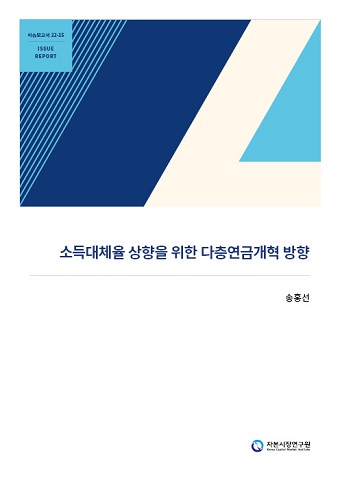Latest Publictions

2022 Aug/16
Reforming Korea’s Multi-Pillar Pension system for Increasing Income Replacement Rates
Issue Papers 22-15
PDF
- Research Topic Asset Management/Pension
- Page 23
- Summary
- This article aims to explore the pension scheme reform to achieve a higher income replacement ratio. As Korea’s combined income replacement ratio ranges from 57% (DC plans) to 61% (DB plans), reform for post-retirement income security should be directed toward achieving higher replacement ratios to ensure a post-retirement life with reasonable living standards. However, given the predicted depletion of pension assets, the public pension reform should focus on how to achieve stability of replacement ratios between generations (financial sustainability). Furthermore, it is necessary to overhaul private pension plans that could help raise income replacement ratios by boosting returns without additional premium payment in order to increase the contribution level within the multi-pillar pension scheme.
Even if the return is maximized through the reform of fund management, the pension fund depletion could be postponed by two to five years at most since the National Pension fund is drying up at a rapid pace. This necessitates an increase in the contribution to achieve financial sustainability. Notably, advanced management of pension assets could reduce the contribution burden significantly, considering that it is expected to generate additional profits that could be translated into 12 to 20 years’ worth of contribution income. In this respect, what is needed is social consensus for raising the contribution level. To this end, how to share the burden of fund deficit should be established and the contribution that the government and the national pension fund could make as trustees through the fund management reform should be reflected in actuarial valuation before the long-term contribution rate is determined.
If private plans—highly inefficient in asset management, compared to the public pension contributions—are overhauled, it is likely to drive up the income replacement ratio without any additional costs. If Korea enhances its pension scheme to the level of advanced economies by introducing fund-type retirement plans, the replacement ratio could climb by up to 5%p to 11%p, approaching the internationally recommended combined replacement ratio of 66% to 68%. Therefore, further discussions of pension reform should center around a multi-pillar approach encompassing public and private pension plans to devise an optimal policy mix for adequate post-retirement income security and the public pension’s financial sustainability.